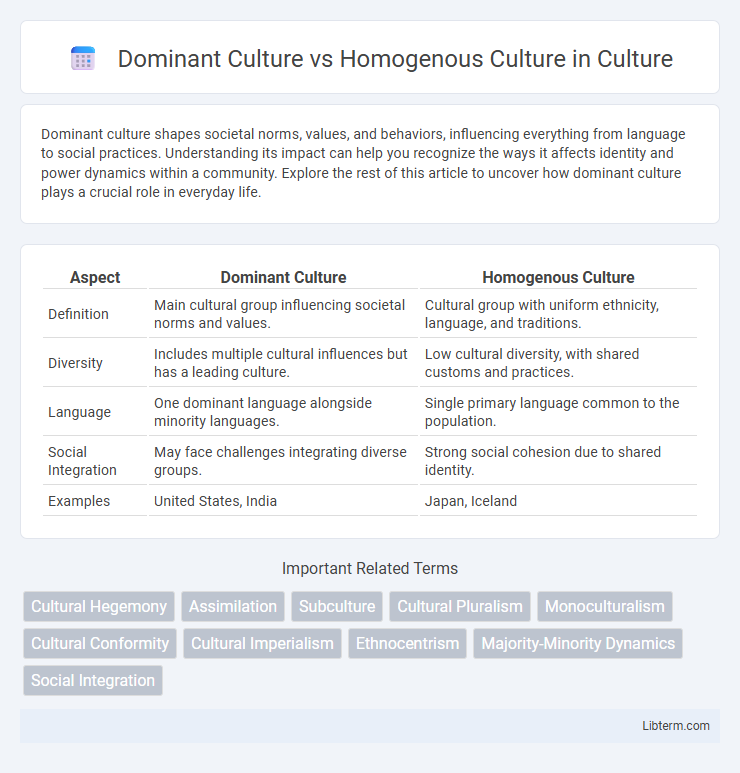Dominant culture shapes societal norms, values, and behaviors, influencing everything from language to social practices. Understanding its impact can help you recognize the ways it affects identity and power dynamics within a community. Explore the rest of this article to uncover how dominant culture plays a crucial role in everyday life.
Table of Comparison
| Aspect | Dominant Culture | Homogenous Culture |
|---|---|---|
| Definition | Main cultural group influencing societal norms and values. | Cultural group with uniform ethnicity, language, and traditions. |
| Diversity | Includes multiple cultural influences but has a leading culture. | Low cultural diversity, with shared customs and practices. |
| Language | One dominant language alongside minority languages. | Single primary language common to the population. |
| Social Integration | May face challenges integrating diverse groups. | Strong social cohesion due to shared identity. |
| Examples | United States, India | Japan, Iceland |
Understanding Dominant Culture
Dominant culture encompasses the set of values, beliefs, and behaviors that prevail and influence societal norms within a diverse population, often shaping laws, education, and media representations. Understanding dominant culture requires recognizing its role in establishing social hierarchies and its impact on minority groups, whose customs and voices may be marginalized or assimilated. Analysis of dominant culture reveals power dynamics and cultural assimilation processes essential for addressing issues of inclusion and equity in multicultural settings.
Defining Homogenous Culture
Homogenous culture refers to a society where members share common language, values, beliefs, and customs, creating a unified social identity. This cultural uniformity often results in strong social cohesion and predictability in social interactions. Unlike dominant culture, which may impose norms on diverse groups, homogenous culture inherently consists of a single, consistent cultural framework embraced by the entire population.
Key Differences Between Dominant and Homogenous Cultures
Dominant culture refers to the cultural practices, values, and norms held by the majority or those in power within a society, often influencing social institutions and governance. Homogenous culture describes a society where cultural attributes, such as language, traditions, and beliefs, are uniform and widely shared among its members, resulting in minimal diversity. The key differences lie in dominance and influence versus uniformity and similarity, with dominant cultures shaping societal structures and homogenous cultures emphasizing cultural sameness.
The Influence of Dominant Culture on Society
Dominant culture shapes societal norms, values, and institutions, often setting the standard for acceptable behavior and social expectations. It influences language, media, education, and legal systems, reinforcing power structures and marginalizing minority cultures within the society. This cultural dominance impacts identity formation and social cohesion, frequently creating a framework where cultural diversity is subordinated to mainstream ideologies.
Homogeneity: Advantages and Disadvantages
Homogeneous cultures foster strong social cohesion and a unified identity, which can lead to stability and efficient communication within a community. However, this cultural uniformity may limit diversity of thought, innovation, and adaptability in changing environments. The lack of exposure to different perspectives can also result in resistance to change and social exclusion of minorities.
Cultural Assimilation and Identity
Dominant culture often drives cultural assimilation by encouraging minority groups to adopt its language, values, and customs, which can lead to a loss of unique cultural identities. In contrast, a homogenous culture maintains a strong, unified identity with shared traditions and social norms that limit the pressure for assimilation. The tension between preserving identity and the influence of dominant culture shapes social integration and multicultural dynamics.
Power Dynamics in Dominant vs Homogenous Societies
Dominant cultures exercise power through established institutions and social norms that privilege certain groups, often marginalizing minorities within diverse societies. In homogenous cultures, power dynamics tend to be more uniform, with cultural norms closely aligned across the population, reducing internal conflict but potentially limiting diversity of thought. Understanding these dynamics is crucial for analyzing social cohesion, representation, and inequality in different societal frameworks.
Diversity and Inclusion in Dominant Cultural Contexts
Dominant cultures shape societal norms and values, often influencing workplace dynamics and social interactions, which can create barriers to true diversity and inclusion. In such contexts, recognizing and valuing diverse cultural perspectives is essential to fostering equitable environments where marginalized groups feel represented and supported. Implementing inclusive policies and practices that challenge dominant cultural assumptions promotes collaboration, innovation, and social cohesion within organizations and communities.
Social Implications of Cultural Uniformity
Cultural uniformity within dominant and homogenous cultures often leads to streamlined communication and social cohesion, reducing conflicts arising from cultural misunderstandings. However, it can also suppress individual expression and minority voices, fostering social exclusion and limiting diversity in thought and innovation. The social implications include the reinforcement of social norms and power dynamics that may marginalize non-conforming groups, impacting social equity and access to opportunities.
Navigating Multiculturalism Amidst Dominant Trends
Navigating multiculturalism amidst dominant culture trends requires understanding how a dominant culture sets prevailing norms, values, and practices that may overshadow minority voices in a heterogeneous society. Emphasizing cultural awareness and inclusivity helps bridge gaps between the dominant culture and diverse communities, fostering social cohesion and mutual respect. Effective multicultural navigation promotes equitable representation and challenges cultural homogenization by valuing pluralism and dynamic identity expressions.
Dominant Culture Infographic

 libterm.com
libterm.com